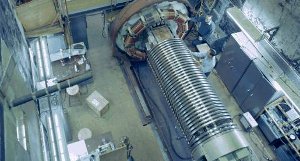The chemical element seaborgium is classed as a transition metal. It was discovered in 1974 by a team of scientists led by Albert Ghiorso.

Data Zone
| Classification: | Seaborgium is a transition metal |
| Atomic weight: | (271), no stable isotopes |
| State: | solid (presumed) |
| Melting point: | |
| Boiling point: | |
| Electrons: | 106 |
| Protons: | 106 |
| Neutrons in most abundant isotope: | 165 |
| Electron shells: | 2,8,18,32,32,12,2 |
| Electron configuration: | [Rn] 5f14 6d4 7s2 |
Reactions, Compounds, Radii, Conductivities
| Atomic volume: | – |
| Structure: | – |
| Hardness: | – |
| Specific heat capacity | – |
| Heat of fusion | – |
| Heat of atomization | – |
| Heat of vaporization | – |
| 1st ionization energy | – |
| 2nd ionization energy | – |
| 3rd ionization energy | – |
| Electron affinity | – |
| Minimum oxidation number | – |
| Min. common oxidation no. | – |
| Maximum oxidation number | – |
| Max. common oxidation no. | – |
| Electronegativity (Pauling Scale) | – |
| Polarizability volume | – |
| Reaction with air | – |
| Reaction with 15 M HNO3 | – |
| Reaction with 6 M HCl | – |
| Reaction with 6 M NaOH | – |
| Oxide(s) | – |
| Hydride(s) | – |
| Chloride(s) | – |
| Atomic radius | – |
| Ionic radius (1+ ion) | – |
| Ionic radius (2+ ion) | – |
| Ionic radius (3+ ion) | – |
| Ionic radius (1- ion) | – |
| Ionic radius (2- ion) | – |
| Ionic radius (3- ion) | – |
| Thermal conductivity | – |
| Electrical conductivity | – |
| Freezing/Melting point: | – |

A small part of the super-HILAC under construction at the Berkeley Lab in 1972. In 1974, seaborgium atoms were synthesized in this accelerator.
Discovery of Seaborgium
Seaborgium was first synthesized in 1974 at the Lawrence-Berkeley Laboratory, USA, by a team of scientists led by Albert Ghiorso and at the Joint Institute for Nuclear Research at Dubna, Russia.
The element was named after Nobel prize winner Glenn Theodore Seaborg, the American nuclear chemist.
Appearance and Characteristics
Harmful effects:
Seaborgium is harmful due to its radioactivity.
Characteristics:
Seaborgium is a radioactive synthetic metal and has only been produced in tiny amounts.
Uses of Seaborgium
Seaborgium is of research interest only.
Abundance and Isotopes
Abundance earth’s crust: nil
Abundance solar system: nil
Cost, pure: $ per 100g
Cost, bulk: $ per 100g
Source: Seaborgium is a synthetic, radioactive metal, created by nuclear bombardment. It has only been produced in tiny amounts. The metal is made by bombarding californium-249 with heavy oxygen ions.
Isotopes: Seaborgium has 11 isotopes whose half-lives are known, with mass numbers from 258 to 271. None are stable. The most stable isotope is 271Sg with a half-life of 1.9 minutes.

References
Cite this Page
For online linking, please copy and paste one of the following:
<a href="https://www.chemicool.com/elements/seaborgium.html">Seaborgium</a>
or
<a href="https://www.chemicool.com/elements/seaborgium.html">Seaborgium Element Facts</a>
To cite this page in an academic document, please use the following MLA compliant citation:
"Seaborgium." Chemicool Periodic Table. Chemicool.com. 09 Oct. 2012. Web. <https://www.chemicool.com/elements/seaborgium.html>.